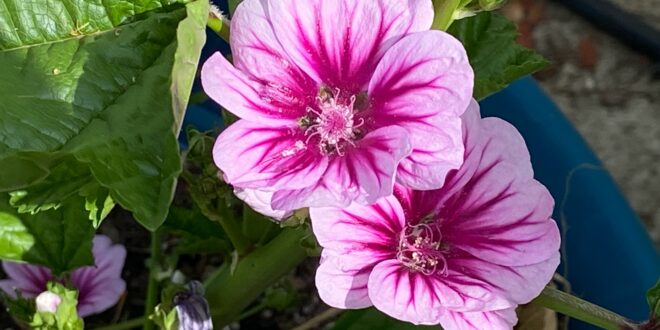Everything about this colorful mallow is perfect, from the dramatic wine-red splashes on pale pink petals, to its drought tolerance and its ready ability to self-seed. Add in that it’s one of the host plants for the Painted Lady butterfly and blooms nonstop from mid-summer to late fall and you have one of nature’s wonder plants. This hollyhock relative first produces rich green, textured palmate leaves on 3′ high plants, then come summer, branch tips sprout an endless number of 2-3” wavy, five-petaled blooms, drawing attention from bees, butterflies and passersby. Undeterred by the heat, this sun lover responds to warmth and a bit of regular water. Though it may act as a short-lived perennial, it will readily produce babies for future years. Its bright foliage and flowers are a perfect complement to the softer grayish-greens of many Salvias. Not fussy about soil but does need good drainage.
Culture
Easily grown in medium moisture, well-drained soils in full sun to part shade. Flower color intensity may be best in full sun. Plants may easily be grown from seed and will self-seed in the garden under most conditions. Plants may be grown as annuals, biennials or short-lived perennials.
Noteworthy Characteristics
Malva sylvestris, commonly known as common mallow but also known as wood mallow, tree mallow and high mallow, is native to Europe, western Asia and northern Africa. It is similar in appearance to the genera Hibiscus and Alcea. Over time, this species has escaped gardens and naturalized in many parts of the world. In North America, it has naturalized throughout southern Canada and the U.S. except for several States in the Deep South (Louisiana to Florida). Stems typically rise to 2-4’ tall clad with rounded to kidney-shaped, rough-hairy, basal leaves (2-4” long) each having 3-7 shallow lobes. Upper leaf lobes have a more triangular shape. Long-stalked, 5-petaled, bright rose-purple flowers with darker stripes along the petals bloom singly or in 3-5 flowered axillary clusters throughout summer (June to August/September). As the flower petals drop, a small, rounded, disc-shaped fruit (10-20 sections) begins to develop, purportedly resembling the shape of a miniature cheese wheel. This has led to a whole series of additional common names for plants in the genus Malva including cheese, cheeses, cheeseplant and cheeseweed.
Genus name is an ancient Latin name.
Specific epithet from Latin means growing in the woods.
Problems
No serious insect or disease problems. Rust typically develops as the summer progresses.
Uses
Borders. Cottage garden. Wildflower meadow.
Common Name: high mallow
Type: Herbaceous perennial
Family: Malvaceae
Native Range: Northern Europe, northern Africa, southwestern Asia
Zone: 4 to 8
Height: 2.00 to 4.00 feet
Spread: 2.00 to 3.00 feet
Bloom Time: July to September
Bloom Description: Rose-purple with darker stripes
Sun: Full sun to part shade
Water: Medium
Maintenance: Low
Suggested Use: Annual, Naturalize
Flower: Showy








